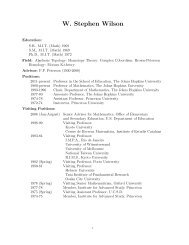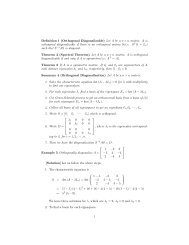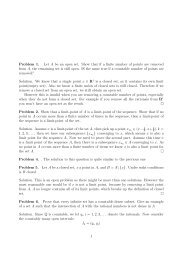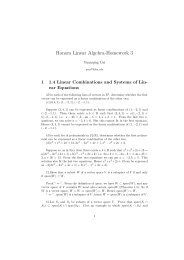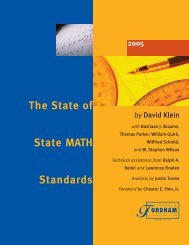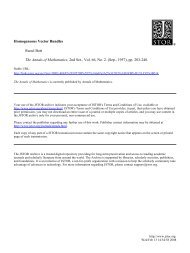Doing the Math - JHU Mathematics - Johns Hopkins University
Doing the Math - JHU Mathematics - Johns Hopkins University
Doing the Math - JHU Mathematics - Johns Hopkins University
You also want an ePaper? Increase the reach of your titles
YUMPU automatically turns print PDFs into web optimized ePapers that Google loves.
APPENDICES<br />
Statement” that accompany it. However, <strong>the</strong>se are not always clear. For example, <strong>the</strong> “Assessment Limits” for<br />
indicator 1.1.1 states: The student will not be asked to draw three-dimensional figures. No fur<strong>the</strong>r reference or<br />
clarification is given with regard to this remark, or what it may imply about <strong>the</strong> indicator, and <strong>the</strong> meaning of it<br />
remains subject to interpretation.<br />
There is also a section of <strong>the</strong> VSC labeled “Additional Topics Would Include,” and each indicator may have several<br />
apparently optional subindicators of <strong>the</strong> form 1.1.1.1 (additional topic 1 for 1.1.1). The publicly available material<br />
for <strong>the</strong> VSC states that <strong>the</strong> additional topics are “content that may be appropriate for <strong>the</strong> curriculum but is not<br />
included in <strong>the</strong> Core Learning Goals.” The state fur<strong>the</strong>r stipulates that students must complete courses in algebra<br />
1/data analysis and geometry that include <strong>the</strong> CLG but fails to mention <strong>the</strong> “Additional Topics.” 2 This seems to imply<br />
that <strong>the</strong> VSC does not necessarily include <strong>the</strong>se topics, so <strong>the</strong> alignment treats <strong>the</strong>m as if <strong>the</strong>y are, indeed, optional.<br />
The “Additional Topics” portion of <strong>the</strong> standards are <strong>the</strong>n sometimes most illuminating in terms of what <strong>the</strong><br />
corresponding indicator does not include. For example, <strong>the</strong> factoring skills that form a large part of classical<br />
algebra are included only as “Additional Topics” in <strong>the</strong> VSC, leading one to conclude that <strong>the</strong>y are not de facto part<br />
of <strong>the</strong> VSC.<br />
The Accuplacer skills are quite straightforward, and are generally <strong>the</strong> skills expected to be contained in traditional<br />
high school ma<strong>the</strong>matics courses. However, reading <strong>the</strong> VSC to determine if a particular skill is covered is no easy<br />
task. The indicators are too broadly stated to discern if a particular skill is included, so <strong>the</strong> “Assessment Limits” and<br />
“Skill Statement” must be carefully considered. Even upon consideration, it is sometimes difficult to determine if a<br />
particular skill is covered. For contrast, one can consider <strong>the</strong> clearly stated and easily understood algebra I content<br />
standards developed in California. 3<br />
C. The VSC for Algebra I/Data Analysis<br />
The VSC for Algebra I/Data Analysis includes CLG 1 and CLG 3. The content of <strong>the</strong> CLG 3 is not relevant to <strong>the</strong><br />
Accuplacer exam. It is included below for completeness.<br />
Note: In <strong>the</strong> following, all material numbered with four numerals is not part of <strong>the</strong> VSC. It is instead included<br />
under <strong>the</strong> heading, “Additional Topics Would Include.” The “Additional Topics” for CLG 3 are not included below.<br />
CLG 1 The student will demonstrate <strong>the</strong> ability to investigate, interpret, and communicate<br />
solutions to ma<strong>the</strong>matical and real-world problems using patterns, functions, and algebra.<br />
1.1 The student will analyze a wide variety of patterns and functional relationships using <strong>the</strong><br />
language of ma<strong>the</strong>matics and appropriate technology.<br />
1.1.1 The student will recognize, describe, and/or extend patterns and functional relationships that are expressed<br />
numerically, algebraically, and/or geometrically.<br />
Assessment Limits<br />
The given pattern must represent a relationship of <strong>the</strong> form y = mx + b (linear), y = x 2 +c (simple quadratic), y =<br />
x 3 +c (simple cubic), simple arithmetic progression, or simple geometric progression with all exponents being<br />
positive.<br />
The student will not be asked to draw three-dimensional figures.<br />
Algebraic description of patterns is in indicator 1.1.2.<br />
2 Retrieved from: http://mdk12.org/share/hsvsc/source/VSC_algebra_hs.pdf)<br />
3 California algebra I content standards. Retrieved from: http://www.cde.ca.gov/BE/ST/SS/mthalgebra1.asp.<br />
<strong>Doing</strong> <strong>the</strong> <strong>Math</strong> 43



